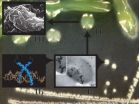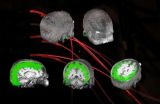(Press-News.org) Respiratory failure caused by chronic lung infection with Pseudomonas aeruginosa bacteria is a common cause of death in patients with cystic fibrosis (CF), a genetic disease that is common in individuals of European descent. A study published on April 24th in PLOS Pathogens demonstrates that an antimicrobial peptide produced by human immune cells can promote mutations in the bacterium that make it more lethal.
Daniel Wozniak, from The Ohio State University Wexner Medical Center, USA, and colleagues studied a process called "mucoid conversion", which involves mutations in Pseudomonas that produce a sticky sugar coating of the bacteria which makes them more resistant to various treatments. The process is fairly well understood, and involves mutation of a particular Pseudomonas gene called mucA. Searching for factors of the human host that facilitate mucA mutation, the scientists found that specific immune system cells called polymorphonucleocytes (or neutrophils), which are present in large numbers in lung cells of patients with CF, can trigger Pseudomonas mucoid conversion, and that a specific antimicrobial factor produced by these cells called LL-37 plays a key role.
At high doses, LL-37 can kill bacteria by poking large holes into their cell walls. However, at lower concentrations (which seem to mimic the situation in the lungs of CF patients), the scientists found that some LL-37 molecules can enter the bacterial cells without killing them. Once inside, LL-37 appears to be able to directly interact with and alter the bacterial DNA, leading to mutation of the mucA gene. The resulting mucoid conversion makes the sugar-coated bacteria then resistant to higher doses of LL-37, including doses that would readily kill the "naked" Pseudomonas bacteria prior to mucoid conversion.
The scientists went on to show that LL-37 can induce mutations besides those in mucA in both Pseudomonas and E. coli, showing that its function as a mutagen is neither restricted to a particular gene nor a particular pathogen.
Taken together, the results demonstrate that an antimicrobial substance can, at low dose, function as a mutagen that makes bacteria more dangerous. Given that antimicrobial peptides similar to LL-37 are being discussed as promising leads for the development of new antibiotics, the scientists say their data "reinforce how important it is to consider the impact of current and novel treatments and the host immune response on evolution of microbial communities during chronic infections."
INFORMATION:
In your coverage please provide this link to the freely available paper:
http://dx.plos.org/10.1371/journal.ppat.1004083 (Link goes live upon article publication)
Contact:
Daniel Wozniak
e-mail: daniel.wozniak@osumc.edu
phone: +1.614.247.7629
Media Relations contact: Eileen Scahill
e-mail: Eileen.Scahill@osumc.edu
phone: +1.614.293.3737
Authors and Affiliations:
Dominique H. Limoli, The Ohio State University, USA
Andrea B. Rockel, Mars Hill University, USA
Kurtis M. Host, University of North Carolina Chapel Hill, USA
Anuvrat Jha, The Ohio State University, USA
Benjamin T. Kopp, The Ohio State University, USA
Thomas Hollis, Wake Forest University School of Medicine, USA
Daniel J. Wozniak, The Ohio State University, USA
Citation: Limoli DH, Rockel AB, Host KM, Jha A, Kopp BT, et al. (2014) Cationic Antimicrobial Peptides Promote Microbial Mutagenesis and Pathoadaptation in Chronic Infections. PLoS Pathog 10(4): e1004083. doi:10.1371/journal.ppat.1004083
Funding: CFF (WOZN10GO) (http://www.cff.org) and National Institutes of Health grants HL058334, AI097511, and NR013898 (DJW) (http://grants.nih.gov/grants/oer.htm) generously supported this work. The funders had no role in study design, data collection and analysis, decision to publish, or preparation of the manuscript.
Competing Interests: The authors have declared that no competing interest exist.
Low-dose natural antimicrobial exacerbates chronic lung infection in cystic fibrosis
2014-04-25
ELSE PRESS RELEASES FROM THIS DATE:
Many patients who could benefit from home dialysis are receiving care in dialysis centers
2014-04-25
Washington, DC (April 24, 2014) — Many kidney failure patients in Australia who could benefit from undergoing dialysis at home are being treated in hospitals and dialysis units, according to a study appearing in an upcoming issue of the Clinical Journal of the American Society of Nephrology (CJASN). This is creating significant costs for healthcare providers and causing unnecessary disruptions to patients' lives.
Home dialysis is more convenient for patients and can provide similar or better care than hemodialysis, which must be done in a clinic. Blair Grace, PhD (Australia ...
Muscle mass linked with physical function and quality of life in dialysis patients
2014-04-25
Washington, DC (April 24, 2014) — Dialysis patients with more muscle mass had better scores on a 6-minute walking test as well as better scores on physical and mental health questionnaires in a study appearing in an upcoming issue of the Clinical Journal of the American Society of Nephrology (CJASN). The findings suggest that physical activity that builds muscle mass may help improve the health and quality of life of dialysis patients.
Physical functional ability is often significantly impaired in patients on maintenance hemodialysis. Srinivasan Beddhu, MD (University ...
Astronomical forensics uncover planetary disks in NASA's Hubble archive
2014-04-25
Astronomers using NASA's Hubble Space Telescope have applied a new image processing technique to obtain near-infrared scattered light photos of five disks observed around young stars in the Mikulski Archive for Space Telescopes database. These disks are telltale evidence for newly formed planets.
If astronomers initially miss something in their review of data, they can make new discoveries by revisiting earlier data with new image processing techniques, thanks to the wealth of information stored in the Hubble data archive. This is what Rémi Soummer, of the Space Telescope ...
Study suggests targeting B cells may help with MS
2014-04-24
PHILADELPHIA – A new study suggests that targeting B cells, which are a type of white blood cell in the immune system, may be associated with reduced disease activity for people with multiple sclerosis (MS). The study is released today and will be presented at the American Academy of Neurology's 66th Annual Meeting in Philadelphia, April 26 to May 3, 2014.
For the study, 231 people with relapsing-remitting MS received either a placebo or one of several low dosages of the drug ofatumumab, which is an anti-B cell antibody, for 24 weeks, with the first 12 weeks making up ...
New guidelines aim to improve care for babies with heart problems in the womb
2014-04-24
Fetal heart experts working with the American Heart Association have developed guidelines to help healthcare providers care for unborn babies with heart problems, as well as their families.
The statement, Diagnosis and Treatment of Fetal Cardiac Disease, is published in the American Heart Association journal, Circulation.
"Congenital heart disease is the most common birth defect that can result in either death or significant health problems in newborn babies," said Mary T. Donofrio, M.D., lead writer of the statement, and director of the Fetal Heart Program and Critical ...
Genetic alterations in shared biological pathways as major risk factor for ASD
2014-04-24
A substantial proportion of risk for developing autism spectrum disorders (ASD), resides in genes that are part of specific, interconnected biological pathways, according to researchers from the Icahn School of Medicine at Mount Sinai, who conducted a broad study of almost 2,500 families in the United States and throughout the world. The study, titled "Convergence of Genes and Cellular Pathways Dysregulated in Autism Spectrum Disorders," was first published online in the American Journal of Human Genetics on April 24.
ASD affects about one percent of the population ...
Controlling brain waves to improve vision
2014-04-24
Have you ever accidently missed a red light or a stop sign? Or have you heard someone mention a visible event that you passed by but totally missed seeing?
"When we have different things competing for our attention, we can only be aware of so much of what we see," said Kyle Mathewson, Beckman Institute Postdoctoral Fellow at the University of Illinois. "For example, when you're driving, you might really be concentrating on obeying traffic signals."
But say there's an unexpected event: an emergency vehicle, a pedestrian, or an animal running into the road—will you actually ...
Computer program could help solve arson cases
2014-04-24
Sifting through the chemical clues left behind by arson is delicate, time-consuming work, but University of Alberta researchers teaming with RCMP scientists in Canada, have found a way to speed the process.
A computer program developed by University of Alberta chemistry professor James Harynuk, his team of graduate and undergraduate researchers and the Royal Canadian Mounted Police National Forensic Laboratory Services, can cut the need for extra levels of human analysis, reducing the waiting time to find out the cause of a deliberately set fire.
That means quicker ...
'Horsing around' reduces stress hormones in youth
2014-04-24
PULLMAN, Wash. – New research from Washington State University reveals how youth who work with horses experience a substantial reduction in stress – and the evidence lies in kids' saliva.
The results are published in the American Psychological Association's Human-Animal Interaction Bulletin this month.
Pendry-80"We were coming at this from a prevention perspective," said Patricia Pendry, a developmental psychologist at WSU who studies how stress "gets under the skin" and the effects of prevention programs on human development. "We are especially interested in optimizing ...
JCI online ahead of print table of contents for April 24, 2014
2014-04-24
Ex vivo expansion of hematopoietic stem cells from cord blood
Compared to hematopoietic stem cells (HSCs) isolated from adults, HSCs isolated from cord blood (CB) have enhanced proliferative potential and can lead to hematological reconstitution when engrafted in children with hematological malignancies or genetic defects. Unfortunately, small numbers of HSCs are present in single CB collections, limiting their use as grafts for adults. For several decades investigators have used a variety of strategies to expand the numbers of CB HSC ex vivo with limited success. Evidence ...


